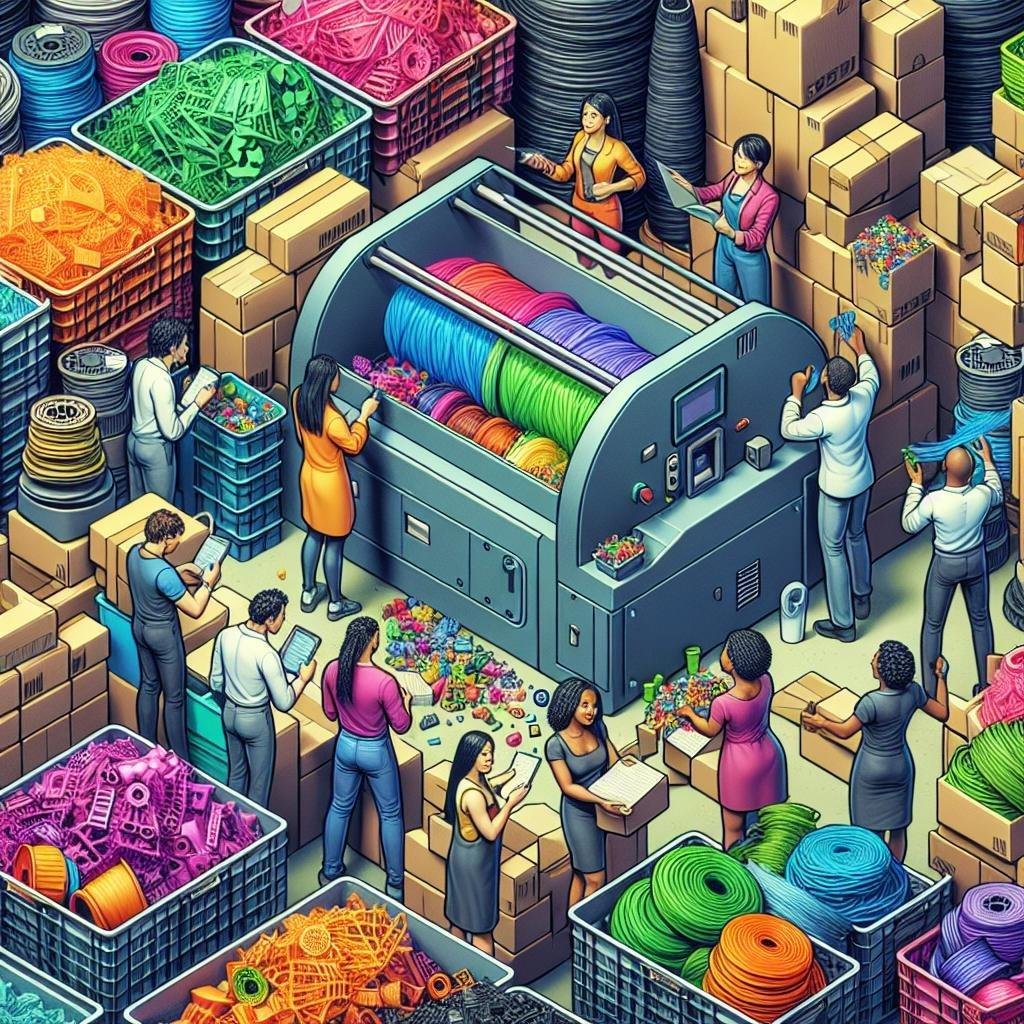In the world of 3D printing, where innovation meets creativity, lies a less glamorous yet equally crucial aspect: waste. Every failed print, support structure, and filament scrap contributes to the mountain of 3D printing debris. but fear not, for in this sea of plastic potential, there is also a world of possibility. Welcome to the vibrant journey of transforming 3D printing waste into enduring treasure! Hear, we unravel the best ways to recycle these colorful castaways, turning what was once discarded into something delightful. Whether you are an eco-conscious maker or simply curious about green practices, join us as we explore inventive, earth-pleasant solutions that merge technology and sustainability in the most magnificent manner. Let’s revolutionize the way we think about waste, and together, transform yesterday’s scraps into tomorrow’s masterpieces.
Transforming Filament Scraps into Functional Treasures
Repurposing the remnants of your 3D printing projects can be a rewarding journey into creative sustainability. Imagine the colorful sparks of possibility hiding in those discarded fragments. Instead of banishing them to the land of forgotten filaments, consider crafting customized coasters or quirky decorative bowls. Simply melt them down and reshape them into unique, personalized treasures. If you have smaller scraps, these can be transformed into vibrant keychains or artistic mosaics by layering different colors to create stunning textures. The key is to let your creativity wander through a playground of possibilities, turning ‘waste’ into wondrous creations that brighten up any space.
| Project Ideas | Use Case |
|---|---|
| Customized Coasters | Table decorations |
| decorative Bowls | Home decor |
| Vibrant Keychains | Accessory |
For the more technically inclined, setting up a small-scale filament recycling system at home could be a fascinating experiment. This process involves grinding the scraps into tiny bits, melting them, and extruding fresh filament for future projects. The prospect of custom-made filament is especially enticing for those passionate about both control and creativity. not only does this practice empower you to take full charge of your print creations, but it also reduces the need for new filament purchases, enhancing the eco-friendliness of your hobby. Just think of all the mesmerizing color layers, textures, and patterns you could generate from a spectrum of mixed scraps, crafting a narrative woven from vibrant artistry and eco-conscious innovation.

Innovative Techniques for Colorful Waste reduction
One ingenious approach to repurpose 3D printing waste involves the practice of filament recycling. Instead of discarding the failed prints and support structures,these plastic remnants can be transformed back into usable filament.Equip your creative space with a quality filament extruder and witness how vibrant fragments can be melted down and re-spooled. This technique not only fosters sustainability but also allows you to experiment with a palette of colors by mixing different scraps to produce one-of-a-kind shades. As a bonus, customized pigments can even reflect unique projects, turning what would have been trash into something that inspires art and innovation.
- Create colorful garden fixtures: Use failed prints as molds for colorful stepping stones or garden markers.
- Craft playful sculptures: Combine whimsical pieces into vibrant contemporary art sculptures.
- Build eco-friendly furniture: Integrate 3D print scraps as decorative inlays in home furnishings.
Another imaginative method is participating in community-driven plastic exchanges or art installations using reclaimed plastic. These community initiatives encourage sharing vibrant waste,uniting local makers in the pursuit of sustainability. Organise or join workshops where 3D printing enthusiasts gather, bringing their discarded filament ends, to design collaborative murals or functional fixtures. These meetups can cultivate a sense of community while fostering an surroundings where creativity transforms waste into worthwhile creations.
| technique | Benefits |
|---|---|
| Filament Recycling | Cost-effective, environmental impact reduction, and custom color creation. |
| Community Initiatives | Fosters innovation, builds community, and reduces landfill waste. |

Eco-friendly Alternatives to Traditional Recycling
Discovering innovative methods to handle 3D printing waste can considerably reduce your environmental footprint while still supporting your creative endeavors. Embrace biodegradable filaments; they decompose naturally, offering a sustainable option that reduces the overall impact on the planet. Consider upcycling your failed prints into new products. with a little creativity, discarded pieces can transform into exciting household items such as plant pot holders, desk organizers, or even new art pieces. Additionally, collaborating with community workshops or maker spaces can foster a shared economy, allowing unused materials to find new life in community projects rather than ending up in the trash.
another creative path lies in recycling filament spools themselves. Rather of discarding them,they can be repurposed into functional items such as cable organizers or even quirky plant stands. To effectively track and manage waste levels, consider keeping a simple inventory system of your materials. Here’s a sample table that you might find useful in tracking:
| Item | Weight (g) | Upcycled Project |
|---|---|---|
| PLA scraps | 250 | Plant pot holder |
| Unused spools | – | Cable organizer |
By adopting these choices, you contribute to a cycle of creativity and sustainability, proving that one person’s waste can indeed be another person’s treasure.

Smart Solutions for a Greener Printing Future
When it comes to repurposing the debris from 3D printing, innovations are sprouting like new leaves on a tree. Recycling filament is a brilliant and sustainable way to ensure that excess plastic doesn’t end up clogging our lands and oceans. Transforming the discarded filament into new spools is much easier with the help of a filament extruder. This nifty device lets you melt down leftover plastic and reshape it into fresh filament,ready for your next creation. If compatible machines are available in your area, you can even join local recycling initiatives that transform 3D print waste back to raw material through specialized processes.
Another innovative approach is crafting stunning artwork and prototypes from unused 3D prints. Rather of discarding failed prints or support structures, try turning them into unique design pieces. follow these steps to maximize your creativity:
- Combine various colors and materials for mosaic-like sculptures.
- Craft miniature landscapes or abstract models using offcuts.
- Create eco-friendly jewelry by shaving or reshaping filament scraps.
Alternatively, consider embedding your leftover prints into everyday items:
| Waste Item | Repurposed Product |
|---|---|
| Plastic scraps | coffee table decor |
| Failed prints | Upcycled pot planters |
| Mixed material pieces | Custom wall art |
Embarking on these creative ventures not only gives a new lease of life to waste, but also contributes positively towards an eco-friendly lifestyle.
Q&A
Article Title: Transforming Scraps into Treasures: Best Ways to Recycle 3D Printing Waste
Q: What is 3D printing waste, and why should we care about recycling it?
A: Imagine crafting a masterpiece layer by layer, only to be left with a pile of colorful yet perplexing scraps. That’s 3D printing waste for you! Recycling this material isn’t just earth-friendly; it helps us save money and inspires creativity. Plus, it prevents those vibrant bits from lingering in landfills for centuries.
Q: What are some simple methods to recycle 3D printing waste at home?
A: The DIY enthusiast in you will love this! Start by collecting leftover filament and failed prints. You can use a shredder to break them down and then re-melt and extrude them into fresh filament. Alternatively, crush them into tiny pieces to use as filler in larger prints. It’s like giving your scraps a second chance to shine!
Q: Are there specific community programs or services for 3D printing recycling?
A: Absolutely! Many local makerspaces and tech hubs have recycling bins specifically for 3D printing waste. Some even host events where makers can swap their scraps or deliver them for proper recycling. It’s a fantastic way to be part of a community passionate about sustainability.
Q: Can 3D printing waste be transformed into new products?
A: Yes, indeed! Think of it as turning a blank canvas into a work of art. Innovators are crafting everything from eclectic jewelry to artistic sculptures using reprocessed filament. There are even companies that offer to take your waste and return it as fresh product materials, ready for your next big idea.
Q: Are there specific types of filament that are easier or more challenging to recycle?
A: Most common filaments like PLA (Polylactic Acid) and ABS (Acrylonitrile Butadiene Styrene) can be recycled, but they require different techniques. PLA is biodegradable and often easier to break down, while ABS can be trickier due to its chemical makeup, but it’s not impractical! The key is knowing the properties of each material to recycle them effectively.
Q: How can we reduce 3D printing waste from the start?
A: Great question! Prevention is the best solution. Start by optimizing your designs to minimize support structures and unused sections. Use slicing software efficiently to reduce failed prints. Lastly, embrace precise calibration-your printer’s way of whispering, “Let’s get it right the first time!”
Q: What is the future of 3D printing waste recycling?
A: The horizon is luminous and promising! As technology advances, so does our ability to recycle more efficiently. We can expect developments in new biodegradable filaments and advanced recycling systems. Imagine a world where every failed print plants a seed of innovation for sustainable creation!
Q: Any final tips for someone new to recycling 3D printing waste?
A: Dive in with curiosity and patience! Explore online tutorials and join forums to learn from others. Mistakes are merely stepping stones to success in 3D printing and recycling. Celebrate each success, no matter how small, and remember-you’re shaping a greener future, one layer at a time!
Final Thoughts
As we journey through the colorful universe of 3D printing, it’s heartening to know that our creative sparks can ignite a wave of sustainability. From transforming filament scraps into vibrant new creations to partnering with forward-thinking recycling initiatives, the power to make a positive impact is in our hands-and within reach of our printers. Whether you’re an avid maker or a curious novice, embracing these eco-friendly practices not only enriches our projects but also nurtures our planet. so, let’s weave the future we wish to see, layer by layer, one recycled masterpiece at a time. Happy printing, and may your imagination always find its greenest shade!

